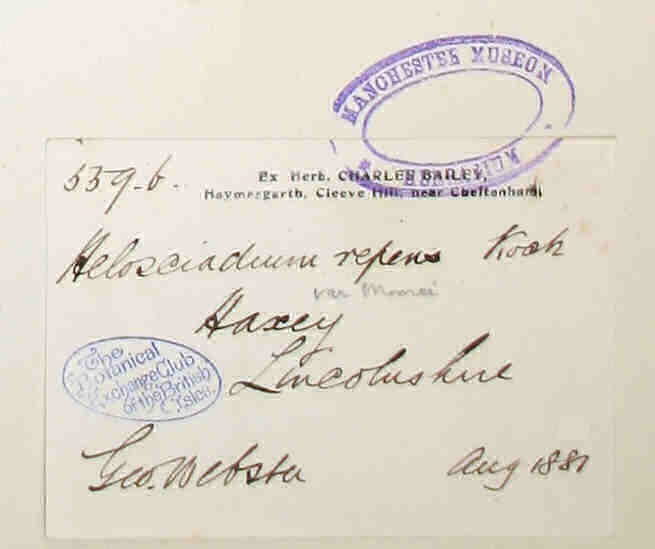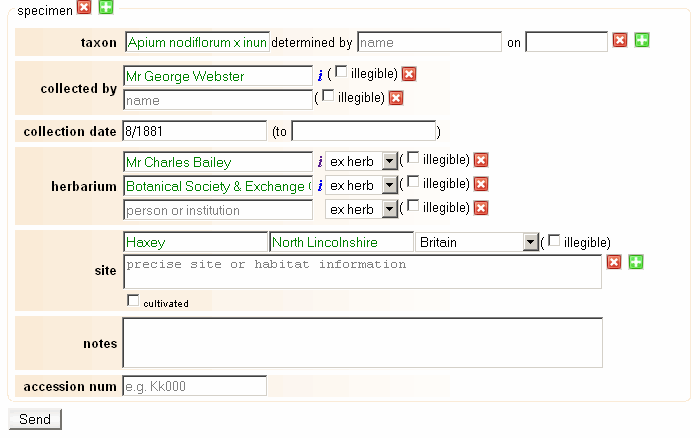How to document a herbarium sheet
From Wiki
Contents |
Documentation guidelines
This page is intended as a guide to herbarium sheets and how to accurately and consistently record the information on them. It's quite likely that you are already familiar with herbarium specimens, and if so, then what follows may be obvious to you. Nevertheless we'd appreciate it if you'd spend a few minutes reading this text, as it's important to the success of the project that everyone follows the same conventions.
There is also a short demonstration video that shows, step-by-step, how to document a specimen on herbarium@home.
The online form used to document specimens is shown below, the exact appearance of the form may vary slightly depending on your web browser software, but the layout will be approximately as shown here.

Taxon names and determination
In general (and unless you know better) you should keep the default taxon name. Very often this will be different from the name on the sheet as taxonomic nomenclature has been updated since the sheet was labelled. If the sheet has specific determination information, you wish to fill in the determiner field, or add previous taxon names. If there are multiple redeterminations then only the most recent identification should be recorded.
Collectors
The collector is the person who went out in the field and picked the specimen. Often their signature or initials will be handwritten on the label.
Legit or leg. is commonly used to denote the collector.
As you start to type in the 'collected by' field the system will display a list of suggested names, whenever possible please choose one of these suggestions. The name list is partly sorted by frequency (major collectors listed first), so where there is ambiguity, the name from the top of the list is often the correct choice.
If in doubt about the identity of a collector, then enter the name as it appears on the sheet.
Dates
Dates need to be recorded with the full year specified, i.e. 14/6/1977 not 14/6/77. However, 6/1977 or 1977 are also acceptable if the information is incomplete. Often the dates written on the specimen label are ambiguous for century, in this case the dates of collectors or the style of the label may be useful as a guide. In general Manchester Museum's collection is 19th or early 20th century.
Date ranges ('from' - 'to') shouldn't be specified unless stated on the sheet label.
Herbarium (provenance)
We'd like to separately record the provenance of specimens. Specimens have often passed through many hands before finally arriving in a museum collection and provenance information is valuable to historians and can also sometimes help to verify the veracity of a record.
Herbaria may be denoted on labels either with stamps, printed labels, or handwritten entries (e.g. ex herb). Specimens often also have stamps related to exchange clubs, which for the current purposes should also be recorded as ex herb entries.
Locality (collection site)
Whenever possible, please try to pick a pre-defined location, and then use the location notes field to narrow down the location further if necessary. If the data set resulting from your hard work is to be useful then it needs to be easily searched, hence the need for standard site names.
Botanical recording uses Watsonian vice-county divisions, a set of standard boundaries defined in 1852. Unlike modern political boundaries, VC borders do not change. Many sheets have the vice county number written on the label in pencil. Whenever possible please try to specify the vice-county, in some cases it will be impossible to be precise, but usually if a town or village name is specified then the vice-county may be found, use this page to find the county for unfamiliar place names.
Many place names will already have been entered into the system, so the quickest way to enter locations is the type in the town or village name in the right-hand box, a list of known locations will appear. Picking from this list will fill in the country and vice-county fields automatically. Frequently, the location may be hard to read, in which case the Google search engine can be a good place to look, as it is surprisingly good at guessing misspellings. There is a link to Google at the bottom of the documentation form. Google will work best if you give as much detail as possible, e.g. include the county name in the search.The spelling of many place names has varied over time, please enter the modern English spelling as listed in the Ordnance Survey gazetteer.
The site notes field (the full width box below the country/region/place name fields) should be used to enter any additional details from the specimen label that precisely define the locality, e.g. 'ballast heaps beside the station' and any other site-related information that does not fit other fields.
Accession number
Some sheets have a museum accession code, typically stamped, but sometimes hand written. This will begin with K or Kk followed by a number.
Notes
This can be used to record any other information from the label which cannot be written in other fields. It can also be used to record comments about the state of the specimen, or to express any other observations.
Please don't worry if the above guidelines seem too daunting every contribution to documenting sheets is welcome. Some herbarium sheets will be missing much of the information requested and many may have illegible labels. But even if you can't read the complete information then your contribution of partial information is still useful.
Example

taxon
Although the sheet is labelled as Helosciadium repens it has been anonymously redetermined as Apium x moorei, and this name will be automatically filled in. You do not need to change the taxon field.
collector
George Webster as the sheet has "Geo Webster" handwritten on it.
collection date
8/1881 (herbaria@home uses the date format day/month/year)
herbarium
The sheet has three stamps on it. 'Charles Bailey', 'Botanical Exchange Club of the British Isles' and 'Manchester Museum'. The first two should be listed under herbarium, but the museum stamp can be safely ignored as the sheet is currently held by Manchester.
As you start to type 'bailey' you may be given a choice of variants in a drop-down list, e.g. "Mr Charles Bailey (1838-1924)", "C. Bailey", "Charles Bailey", "Mrs Bailey" etc. In this case although any of the first three are correct, you should choose the first, both because it is first (signifying most commonly occurring) and because it is a more complete entry with full title and date of birth and death.
In some case the choice is harder, for example if the sheet only said "C. Bailey" then the default safe choice would be the "C. Bailey", however if you are certain as to identity then the full name "Mr Charles Bailey" would be the ideal choice.If in doubt just type what is on the label.
site
The sheet label states "Haxey, Lincolnshire". Typing 'Haxey' into 'town/village' field gives a drop down list. If Haxey is picked from the list then the county (Lincolnshire) and country (Britain) are filled in automatically.
notes
There are no extra details to record.
accession number
There is no accession lot number on the label. Such numbers are usually stamped, but occasionally handwritten, but invariably begin with K or KK.




